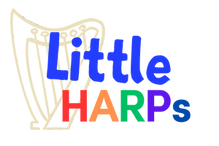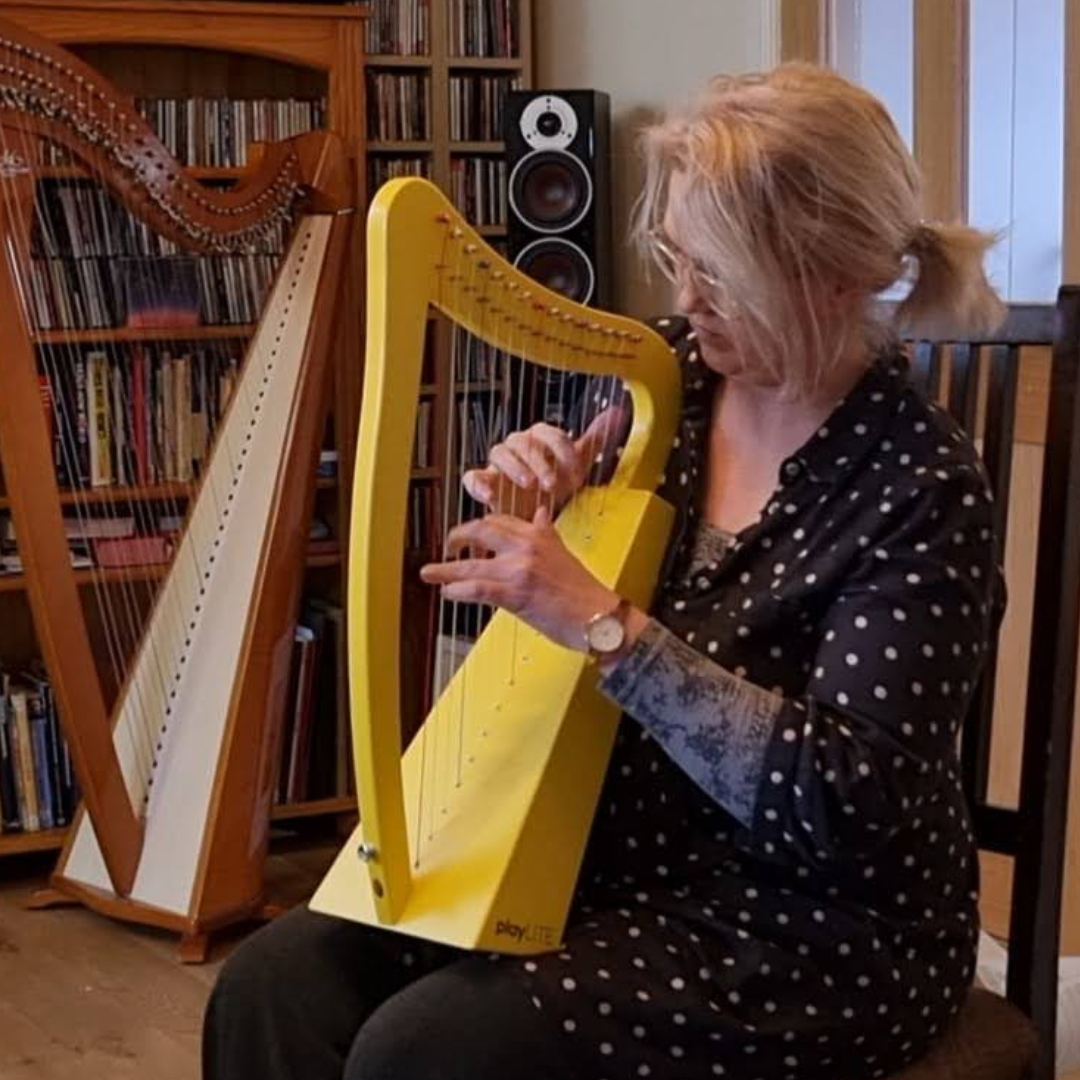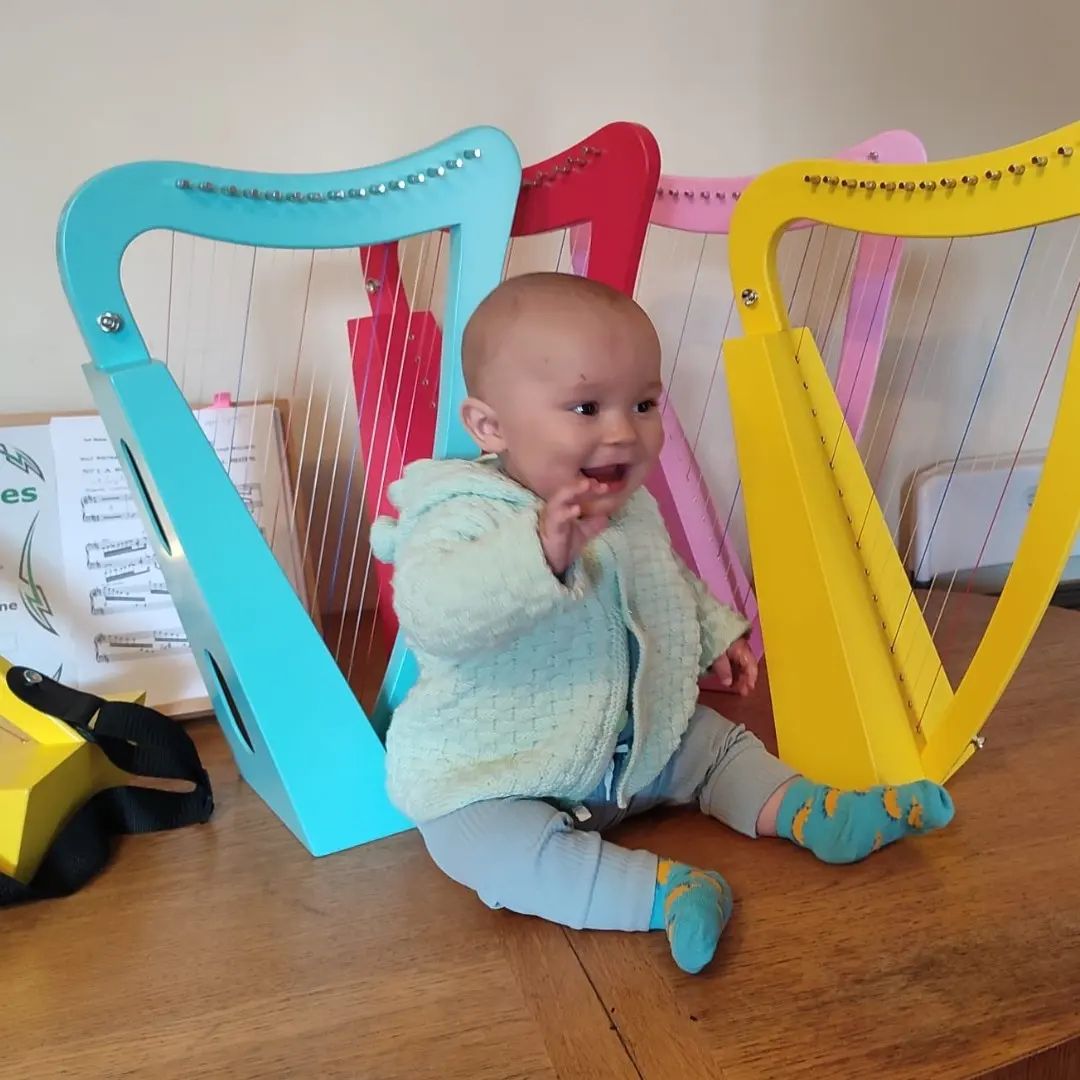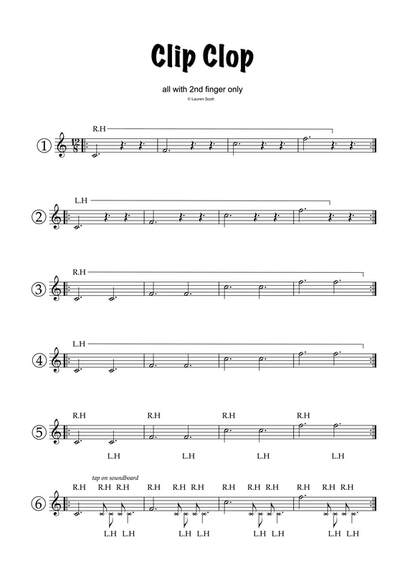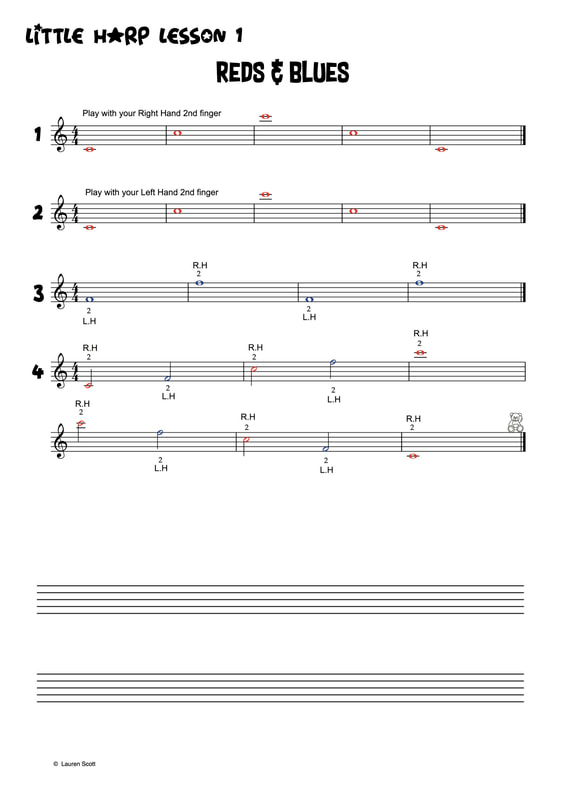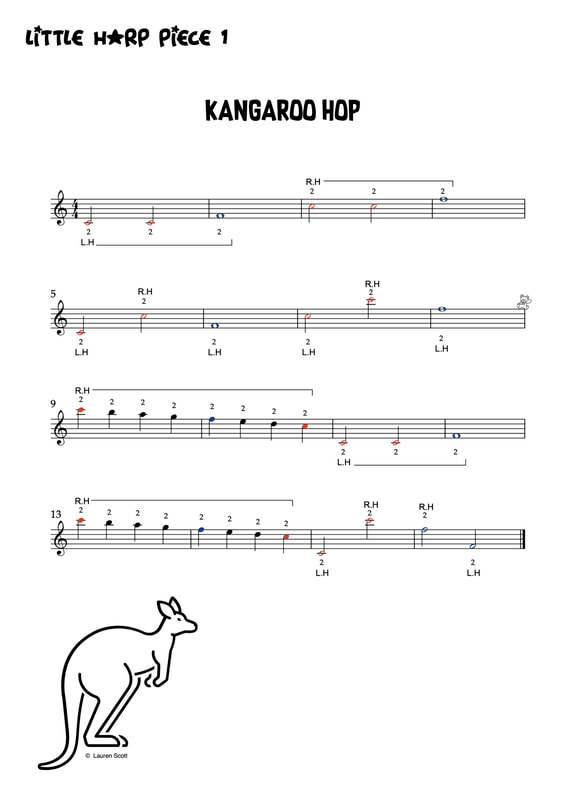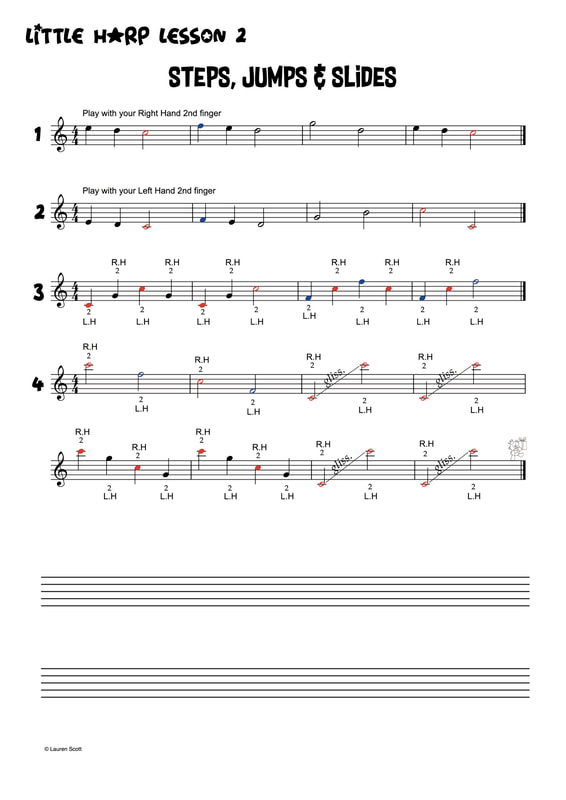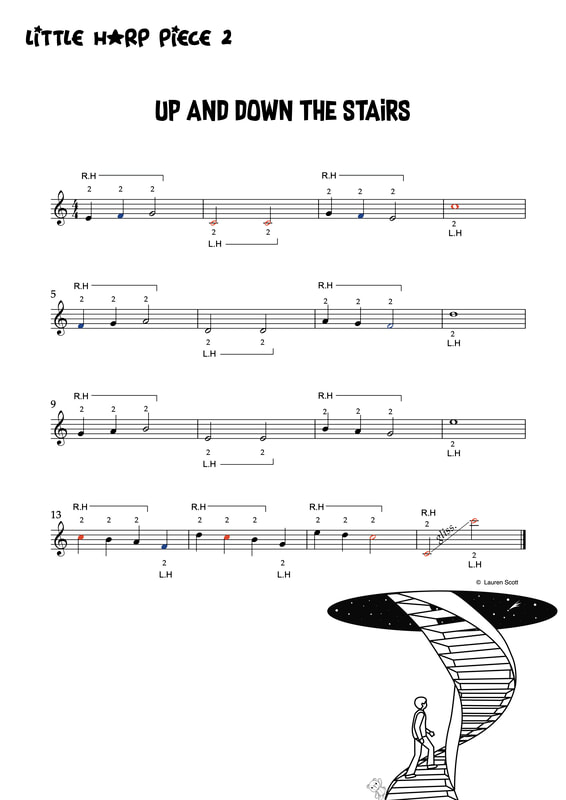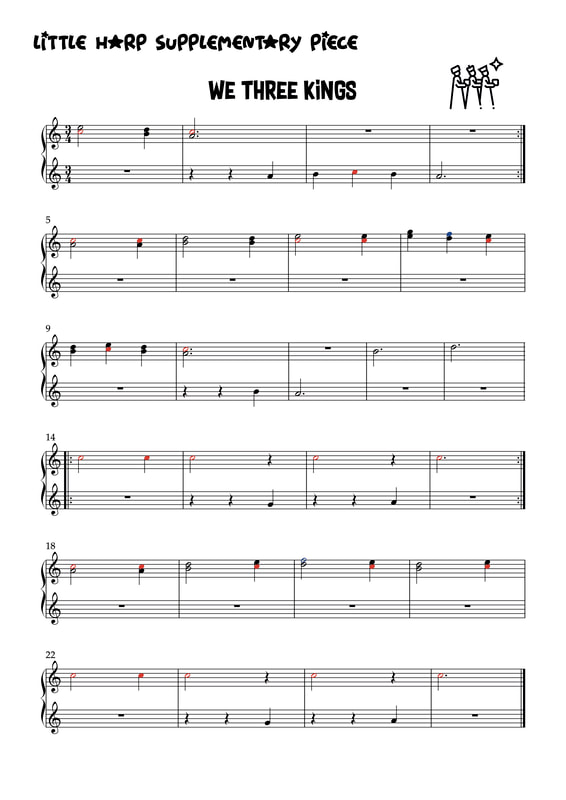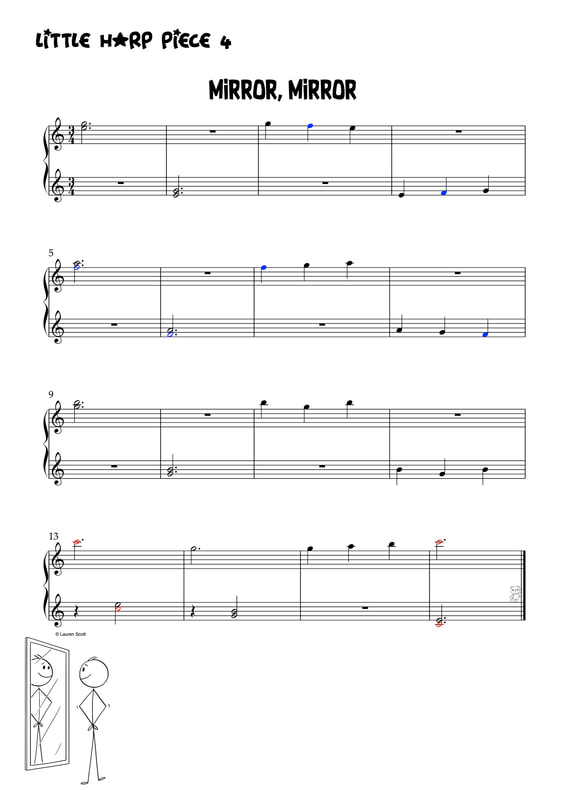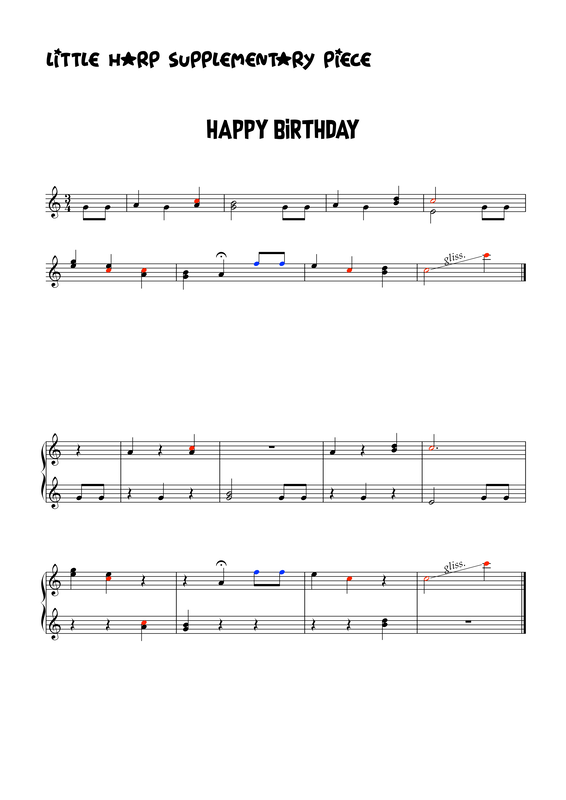The contents of this webpage are exclusively for subscribers to Lauren's newsletter. Thank you!
If you haven't already subscribed to my email newsletter please sign up below
If you haven't already subscribed to my email newsletter please sign up below
|
| ||||
Little Harp Teaching Notes
This is an early year’s programme for learning the harp suitable for children aged 4 upwards using a 15-string harp.
It can be used in group lessons as well as individual lessons and has been designed so that it can be taught by either a harp tutor or a non-harp-specialist tutor.
It is expected that the tutor (if they are not a harpist) would collaborate with their local harp tutor who would guide & support them in the correct playing technique for this programme.
The focus of this programme is primarily on learning basic music theory through playing the harp. By the end of the programme the students should be able to
The aim is that after completing this programme, (if learning from a non harp-specialist tutor) the student would then move on to a specialist harp tutor and use one of the many excellent beginners harp methods that are available.
How to use this programme
Harp technique
This programme deliberately uses only the 2nd finger and playing thirds (together in one hand). This will help to keep the technical emphasis on fingers pointing down (and not sideways) whilst giving time to learn general music theory and how to read notated music. This gives the student an excellent head start for when they upgrade to a larger harp with levers and start using an established harp method.
If the local harp tutor wants to work in collaboration with a guitar tutor who is already teaching within primary schools, the harpist should support the guitar tutor to deliver this programme within the school so that the guitar tutor adds teaching harp to their instrument rosta. After an academic year, the student will have either decided that they want to carry on with learning the harp and will want to upgrade to a lever harp and should then move on to have private lessons with the local harp tutor. If the student decides to stop learning the harp, the financial outlay has been minimal for the parent and the instrument can be hired out to a new student. By creating a partnership with your local guitar tutor who will already be teaching ukulele & guitar in schools, this collaboration can work well for both the local harp tutor and guitar tutor. The guitar tutor gains more students within school, and the harp tutor will receive a keen student who, after completing this programme, is well prepared to continue learning the harp!
If a specialist harp tutor is planning on teaching this programme, it is recommended that they teach this programme in small groups for up to 30 minutes maximum lesson time for a fixed period over an academic year.
It is recommended that the harpist invests in a ‘pool’ of 15 string harps to be hired out to the students at nominal amount (suggested amount of around £5 a month). These instruments need a lot of tuning when they are brand new to get them into a stable pitch. These instruments will be suitable for a student to use for up to one academic year, after which time the student would have a good idea whether they want to continue learning the harp. At this point the parents will need to upgrade to a larger lever harp.
This plan consists of a 'lesson' followed by a 'piece'. Please work through these in order. There are also supplementary pieces which can be taught at any time of the course.
It is recommended that you only teach one thing ('lesson', 'piece' or supplementary piece) at any one time. Be guided by the pace of the student. It could be that it takes several sessions to get through just one 'lesson' or 'piece', and that you can only get through a couple of bars/measures in a session. This is absolutely fine! Teach at whatever pace will ensure success for the student. The aim is for the student to enjoy playing and start to understand music theory.
Complete the lesson sheet before teaching the 'piece' to instil the discipline of needing to work on study material as well as pieces.
This is an early year’s programme for learning the harp suitable for children aged 4 upwards using a 15-string harp.
It can be used in group lessons as well as individual lessons and has been designed so that it can be taught by either a harp tutor or a non-harp-specialist tutor.
It is expected that the tutor (if they are not a harpist) would collaborate with their local harp tutor who would guide & support them in the correct playing technique for this programme.
The focus of this programme is primarily on learning basic music theory through playing the harp. By the end of the programme the students should be able to
- Find and play all the notes on the harp.
- Play using both hands independently.
- Understand basic music theory.
The aim is that after completing this programme, (if learning from a non harp-specialist tutor) the student would then move on to a specialist harp tutor and use one of the many excellent beginners harp methods that are available.
How to use this programme
- Tutor demonstrates (in small sections) so that the student learns by copying.
- Tutor covers theory concepts by explanation with emphasis on identifying note direction, patterns in the music, and intervals.
- Student recaps want they have just been taught to play.
- Tutor then shows the student the written music and focuses on showing them just one or two aspects of music theory written down that was covered in the lesson.
- Student plays again what they have been taught, so that they can play it from memory.
- It is not expected that the student will be note reading from the sheet music as they learn.
- The music theory is to be explained in broad strokes, with only one or two concepts per lesson.
- The emphasis is on enough demonstration by the tutor, copying by the student & playing repetition within the lesson that the student will have memorised the music and be having fun playing the harp.
- The tutor should only teach as much content in the lesson as the student can successfully copy and repeat within the lesson.
- The balance within the lesson should be 60% playing harp & 40% theory.
- Learning to read individual note names should be secondary to understanding general music theory concepts and understanding pulse & rhythm.
- Focus should be placed on being able to recognise C’s (red notes) and F’s (blue notes) on notated music.
Harp technique
- Making a fist
- 2nd finger points down
- 2nd finger pulls in when playing
- Thumbs up
- Elbows out [prompt “chicken wings”]
- Straight finger for glissandos [prompt “pointy finger”]
- Playing thirds [prompt “squeeze together”]
This programme deliberately uses only the 2nd finger and playing thirds (together in one hand). This will help to keep the technical emphasis on fingers pointing down (and not sideways) whilst giving time to learn general music theory and how to read notated music. This gives the student an excellent head start for when they upgrade to a larger harp with levers and start using an established harp method.
If the local harp tutor wants to work in collaboration with a guitar tutor who is already teaching within primary schools, the harpist should support the guitar tutor to deliver this programme within the school so that the guitar tutor adds teaching harp to their instrument rosta. After an academic year, the student will have either decided that they want to carry on with learning the harp and will want to upgrade to a lever harp and should then move on to have private lessons with the local harp tutor. If the student decides to stop learning the harp, the financial outlay has been minimal for the parent and the instrument can be hired out to a new student. By creating a partnership with your local guitar tutor who will already be teaching ukulele & guitar in schools, this collaboration can work well for both the local harp tutor and guitar tutor. The guitar tutor gains more students within school, and the harp tutor will receive a keen student who, after completing this programme, is well prepared to continue learning the harp!
If a specialist harp tutor is planning on teaching this programme, it is recommended that they teach this programme in small groups for up to 30 minutes maximum lesson time for a fixed period over an academic year.
It is recommended that the harpist invests in a ‘pool’ of 15 string harps to be hired out to the students at nominal amount (suggested amount of around £5 a month). These instruments need a lot of tuning when they are brand new to get them into a stable pitch. These instruments will be suitable for a student to use for up to one academic year, after which time the student would have a good idea whether they want to continue learning the harp. At this point the parents will need to upgrade to a larger lever harp.
This plan consists of a 'lesson' followed by a 'piece'. Please work through these in order. There are also supplementary pieces which can be taught at any time of the course.
It is recommended that you only teach one thing ('lesson', 'piece' or supplementary piece) at any one time. Be guided by the pace of the student. It could be that it takes several sessions to get through just one 'lesson' or 'piece', and that you can only get through a couple of bars/measures in a session. This is absolutely fine! Teach at whatever pace will ensure success for the student. The aim is for the student to enjoy playing and start to understand music theory.
Complete the lesson sheet before teaching the 'piece' to instil the discipline of needing to work on study material as well as pieces.
One off - come and try the harp session
LITTLE HARPS - 'Come and Try the Harp' session BACKING TRACK
created by & copyrighted by Scott Audio Collective
created by & copyrighted by Scott Audio Collective
|
This is a guided session led by the tutor, who will do 'call and response' with the participants using the backing track.
Tutor demonstrates making a fist elbows out ('chicken wings') plucking with 2nd finger identifying red notes = C and blue notes = F Suggested "calls" are on the accompanying TUTORS NOTES PDF Once the group can respond to one call after it has been demonstrated to them, move on to the next call for the group to copy and respond to. The students play by ear after it has been demonstrated to them and do NOT use sheet music
| |||
Lesson plans
|
| ||||
Suggested theory topics to cover during lesson 1.
- STAVE (STAFF) - turn harps sidewise and show how it's like the written stave - notes that live on the bottom of the stave are higher than notes that live higher
- SCALE - (notes that are step by step, rather than anything more in depth!)
- TREBLE CLEF
- Pluck, not tickle (pluck = finger pointing down, tickle = finger pointing sideways)
- elbows out (chicken wings)
|
| ||||
Suggested theory topics to cover during lesson 2.
- Looking for and identifying patterns, notes going up or down
- identifying low notes and high notes on stave
- keeping hands near harp ready to play and not on lap
- reminding about previous technical pointers.
|
| ||||
Suggested theory topics to cover during lesson 3.
- Crotchet (quarter note), minims (half notes)
- bars (measure) & bar lines
- time signature - every bar has to add up to 4 in this lesson
- counting the beats of the bar out loud whilst playing
- identifying the notes Middle C and A above the stave
- reminding about previous technical pointers.
- recognising root chord shape
- placing both hands at the same time
Suggested theory topics to cover during We Three Kings
| |||
Suggested theory topics to cover during Jingle Bells
| |||
|
| ||||
Suggested theory topics to cover during lesson 4.
- rests - identifying different types
- writing out crotchet (quarter notes) rests (standing up to take a rest), minim rests (lying down on the sofa), semibreve rest (snoozing in a hammock)
- time signature - adding up the value of rests & notes in each bar
- reminding about previous technical pointers.
Suggested theory topics to cover during Happy Birthday
| |||
|
| ||||
Suggested theory topics to cover during lesson 5.
- quavers (eighth notes)
- whole bar rest
- octaves
- counting out the half beats whilst playing - 1 and 2 and 3 and - etc
- reminding about previous technical pointers.
|
| ||||
Suggested technical pointers
- thumb up whilst playing thirds
- alternating hands
- tied notes
- Da Capo (using Italian words for musical terms. Other Italian words... Italian food etc. !)
- counting out the half beats whilst playing - 1 and 2 and 3 and 4 and - etc
|
Alternative Duet/Ensemble version of Piece 6
| |||
